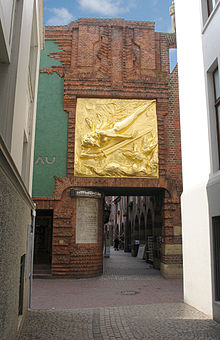Böttcherstraße

Böttcherstraße is a street in the historic centre of Bremen, Germany. Only about 100 m (330 ft) long, it is famous for its unusual architecture and ranks among the city's main cultural landmarks and visitor attractions. Most of its buildings were erected between 1922 and 1931, primarily as a result of the initiative of Ludwig Roselius, a Bremen-based coffee-trader, who charged Bernhard Hoetger with the artistic supervision over the project. The street and its buildings are a rare example of an architectural ensemble belonging to a variant of the expressionist style. Several of the houses can be classed as Brick Expressionism. Since 1973, the ensemble has been protected by the Monument Protection Act.[2]
Overview



Roselius, a sympathiser of
History
The history of Böttcherstraße goes back to the Middle Ages. It constituted an important link between the market square and the Weser river. It was traditionally inhabited by coopers (Northern German: Böttcher). When the harbour was relocated in the mid-19th century, Böttcherstraße's importance began to fade.
In 1902 (some sources say 1906), Ludwig Roselius, under pressure from the previous owners, bought the house at 6 Böttcherstraße (today's
In contrast to these buildings, in 1926, Ludwig Roselius had the Paula Modersohn-Becker-Haus built to serve as a museum dedicated to the painter Paula Modersohn-Becker. The building's external walls have relief-like decorations, and its internal rooms follow principles of organic architecture.
In 1931 the Atlantis House (Haus Atlantis) was completed. Its distinctive style and materials (glass, steel, and concrete) produced a further striking contrast to the other structures. The Robinson Crusoe House (Robinson-Crusoe Haus) was also erected in 1931.
In early 1934
In 1944, large proportions of Böttcherstraße were destroyed by aerial bombing. By 1954, the Kaffee HAG company had restored most of the facades to their original state.
In 1979, Ludwig Roselius Jr. sold the Kaffee HAG company, along with Böttcherstraße, to General Foods. Two years later, he bought Böttcherstraße back. Since then, it has been privately owned.
Significant damage to the building fabric became apparent in 1989. The
In 2004 ownership passed to a foundation (Stiftung Bremer Sparer Dank). It is now administrated by Böttcherstraße GmbH, a limited company and subsidiary of Sparkasse Bremen.
Present
Today, Böttcherstraße is one of the major tourist attractions of Bremen. It contains several art museums (Museen Böttcherstraße), Arts and crafts workshops, bars, restaurants, shops and a hotel. Nearly all buildings and plots are owned by the foundation. A major attraction is the carillon of Meissen porcelain bells at the Glockenspiel House which chimes three times a day.[9]
Bibliography
- Ludwig Leidig: Bombshell. Sbpra 2013, ISBN 978-1-62516-346-2
- Arn Strohmeyer: Der gebaute Mythos: Das Haus Atlantis in der Bremer Böttcherstraße – ein deutsches Missverständnis. Donat, Bremen 1993, ISBN 3-924444-67-6
- Arn Strohmeyer: Parsifal in Bremen. Richard Wagner, Ludwig Roselius und die Böttcherstraße. VDG, Weimar 2002, ISBN 3-89739-263-1
- Hans Tallasch (Hrsg.): Projekt Böttcherstraße. Aschenbeck & Holstein, Delmenhorst 2002, ISBN 3-932292-29-4
See also
References
- ^ Elisabeth Schmidle (2006). "Schandmal oder Mahnmal" (PDF). Der Bürger im Staat (in German). Stuttgart, Germany: Landeszentrale für politische Bildung Baden-Württemberg. p. 188 (54 pdf). Retrieved 23 July 2010.
- ^ "Database of Landesamt für Denkmalpflege Bremen #0209,T". (in German)
- ^ Bremer Nachrichten, 1926 [1] [2] (PDF)
- ^ Roselius, L. (1933). Erstes Nordisches Thing. Deutschland: Angelsachsen-Verlag., p. 10, at Google Books (snippet only)
- ^ Der Parteitag der Ehre vom 8. bis 14. September 1936 Offizieller Bericht über den Verlauf des Reichsparteitages mit sämtlichen Reden, p. 68, at Google Books, "We have nothing to do with those elements that only know National Socialism from hearsay and thus easily confuse it with undefinable nordic phrases, starting their motif research in a fabulous Atlantic culture. National Socialism rejects that kind of culture in the style of the Böttcherstraße most sharply". (Hitler, translated)
- ^ Puschner, Uwe, and Clemens Vollnhals (eds.). Die völkisch-religiöse Bewegung im Nationalismus. Eine Beziehungs- und Konfliktgeschichte. Göttingen: Vandenhoek & Ruprecht, 2012.
- ^ Volker Bergmann, Dieter Pfliegensdörfer; Project group: Willi Elmers, Manfred Fittkau, Wolfgang Günther, Michael Jung, Michael Wolf. Wellblech & Windkanal. Arbeit und Geschäfte im Bremer Flugzeugbau von den Anfängen 1909 bis heute. Steintor, 1989
- ISBN 0-340-16747-5
- ^ "Böttcherstraße: Welcome". Böttcherstraße GmbH. Retrieved 27 January 2014.
External links
53°04′30″N 08°48′20″E / 53.07500°N 8.80556°E
